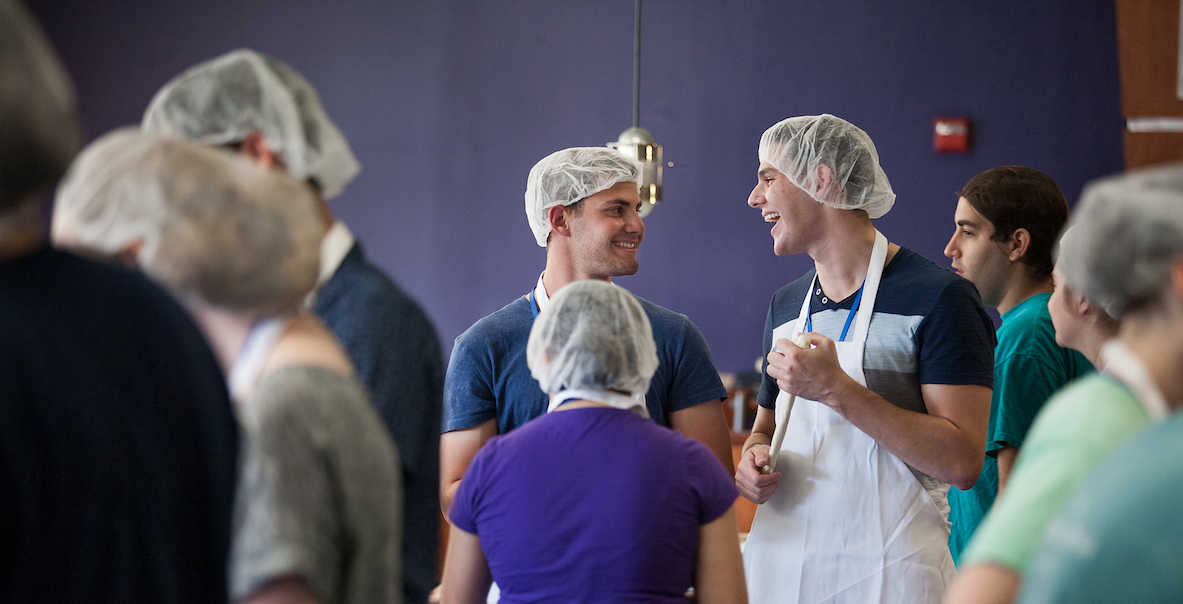In the 13 years since starting on a college campus in California, Challah for Hunger—now based in Philly, with 10,000 student volunteers nationally—has sold over 100,000 loaves of bread and raised more than $1 million for hunger-fighting organizations around the country.
But until recently, even while Challah for Hunger spread from campus to campus, one group of hungry people went virtually unnoticed: The college students in their midst. According to a 2016 report, “Hunger on Campus: The Challenge of Food Insecurity for College Students,” 48 percent of over 3,000 respondents to a survey reported food insecurity in the previous 30 days, with 22 percent at very low levels of food security. The problem is growing, partly as a result of higher tuition rates, higher living expenses and lower access to financial aid.
“We saw that students were having to choose between buying books and buying food,” says Carly Zimmerman, CEO of Challah for Hunger. “Many were working multiple jobs and having to skip classes just to get by. That really hit us.”
Now Challah for Hunger is bringing its mission closer to home, through The Campus Hunger Project, an educational campaign and national research project with the goal of finding long-term solutions to on campus hunger among students. The program, which launched in 2016, has two main initiatives to start: Interviewing campus administrators across the country to find out where they stand in terms of making significant changes for students affected by hunger; and working with nine students at eight colleges to research, plan and enact programs to address hunger on their campuses.
The hope is that those pilots will uncover real solutions that can then be launched broadly, to create a widespread safety net that lets students be students, without worrying about where their next meal is coming from.
“It’s not just fighting hunger for people in your city or your state,” Zimmerman says. “It’s fighting for the classmate that’s sitting next to you who might not have had a meal or had a choice between buying a textbook or something to eat.”
Challah for Hunger is already an example of what college students can accomplish on their own. It was founded in 2004 at Scripps College in California by a group of friends looking to stay connected with the Jewish community, as well as tie in social justice issues they cared about. They started getting together to bake bread and talk about these issues. Soon, the small get-togethers grew, and over a decade later, Challah for Hunger has found a home on more than 80 campuses across the U.S., Canada, the U.K., and Australia.
Zimmerman, who became CEO in 2013, the same year the nonprofit moved its headquarters to Philly, started the group’s 8th chapter when she was a student at University of Pittsburgh in 2006—even though, she readily admits, she wasn’t much of a baker. “I saw this student at Scripps [University] using challah bread as a way to gather people together and get them involved in social justice issues,” she says. “And I thought, ‘What a great way to trick people into caring about these issues.’”
“It’s not just fighting hunger for people in your city or your state,” Zimmerman says. “It’s fighting for the classmate that’s sitting next to you who might not have had a meal or had a choice between buying a textbook or something to eat.”
Today, each chapter of the group bakes anywhere between 30 and 300 loaves to sell to students, professors, and visitors on campuses, with most of the funds going to MAZON, a Jewish hunger-fighting organization.
The new focus, on campus hunger, dovetails with the work of Temple sociology professor Sara Goldrick-Rab, who has been studying and working to address food insecurity at colleges for a decade, starting when she was at University of Wisconsin-Madison from 2004 until 2016. There, she founded the Wisconsin HOPE Lab, an organization with a mission to bring attention to the challenges of college food and housing insecurity and on ways to combat them.
Goldrick-Rab came to Temple in 2016, and plans to open the HOPE Center for College, Community, and Justice at Temple University in 2018; this year was named the 10th most influential U.S. educational policy scholar by Education Week.
Over the last decade, Goldrick-Rab has taken a deep look into the efficacy of financial aid policies, welfare reform, and the ways marginalized demographics can gain better access to higher education. While colleges are starting to make changes, Goldrick-Rab says, it isn’t happening fast enough. “It is a largely invisible problem,” she says. “And it affects as many as half of all undergraduates. People are just starting to wake up.”
According to a Wisconsin HOPE Lab report, “Hungry And Homeless In College: Results From A National Study of Basic Needs Insecurity In Higher Education,” between 31 and 32 percent of students experiencing food or housing insecurity were both working and receiving financial aid. But in many cases, the report adds, these efforts were not matched by other forms of support. For example, it’s estimated that 63 percent of parenting students were food insecure and almost 14 percent were homeless, but only about five percent received any child care assistance.
While the numbers may seem dismal, Goldrick-Rab and her team have developed strategies to improve policy and practices among community college campuses, particularly by identifying institutional leaders specifically charged with assessing and addressing students’ basic needs security.
These strategies, and others, inform Challah’s Campus Hunger Project. In the first year of the project, the group sent students to interview administrators at 32 schools, to find out what they knew about hunger on their campuses, and what programs were in place to help students in need. What they found was that many campuses lacked coordination and communication between offices and students, therefore making it difficult to get students the aide they need, and any resources that did exist varied greatly from institution to institution, with no standard for dealing with hunger on campus. In addition, a general lack of awareness proved to be a problem across the campuses they interviewed on.
With this information, over the next two years, they plan to conduct awareness-building interviews with campus administrators at all of the colleges where Challah is active; partner with existing national hunger-fighting groups; and launch a series of campus-specific projects with their cohort of nine students.
In October, The HOPE Center hosted #RealCollege: A National Convening On College Food & Housing Insecurity, where they heard from Goldrick-Rab and others about how to use their platform to create safer and less hungry campuses for their fellow students. “A lot of the change can happen from students making a difference in their community,” says University of California-Davis sophomore Hana Minksy, who attended the conference. “We’re helping to reduce stigma on more of a ground level.”
According to a 2016 report, “Hunger on Campus: The Challenge of Food Insecurity for College Students,” 48 percent of over 3,000 respondents to a survey reported food insecurity in the previous 30 days, with 22 percent at very low levels of food security.
At Temple, Gadi Zimmerman, president of the school’s Challah for Hunger chapter (and Carly Zimmerman’s brother-in-law), has already started his effort to fix the problem on his campus. Through bread sales in the student center, Challah is raising money for a free food pantry for students on campus, something campuses around the country are increasingly making available.
Minsky plans use her position as Challah volunteer coordinator at UC-Davis to help draw attention to her school’s food pantry and other resources that exist on campus for students in need. “Even if you don’t personally need to use a pantry, just knowing the location and being willing and able to talk about it could really help someone,” she says.
What much of this comes down to is awareness, visibility, and willingness to broach the subject. For members of Challah for Hunger, The Campus Hunger Project, and students across the country, conversation (plus some freshly baked challah bread) is the first step in engaging with the issue. “I want to encourage people to take a look into their own communities,” Minksy says. “Even if they feel like the issue is insurmountable, it really is the small things that can make a big difference.”
![]()
RELATED
Header photo: Challah for Hunger




